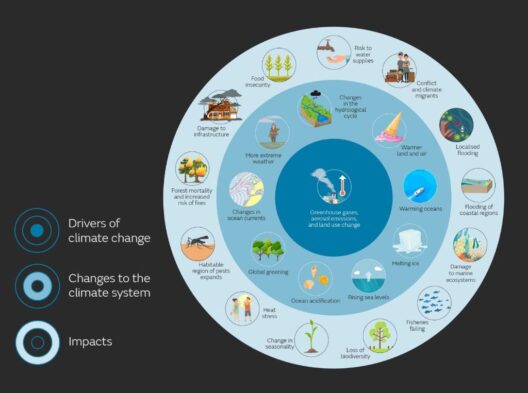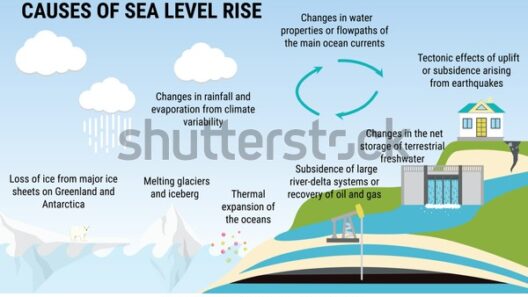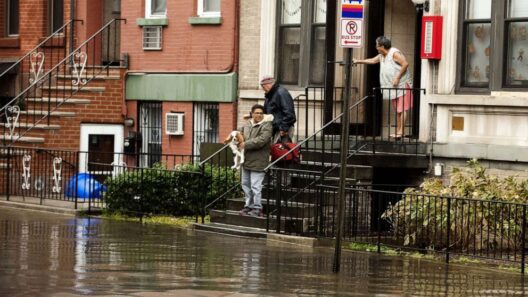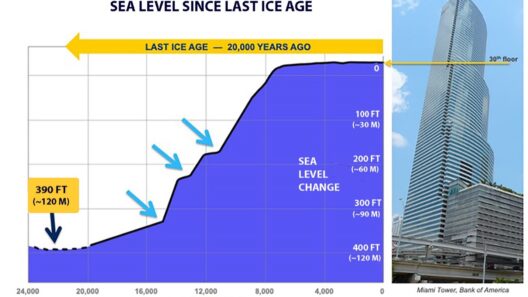As we navigate through the 21st century, the repercussions of climate change are becoming increasingly palpable, with one particularly insidious manifestation: rising sea levels. This phenomenon not only presents grave environmental challenges but also jeopardizes economic stability across the globe. Understanding why rising sea levels are detrimental requires a multifaceted examination of their environmental and economic ramifications.
When we speak of rising sea levels, we primarily refer to two key drivers: thermal expansion of seawater as it warms and the melting of glaciers and polar ice caps. The implications of this natural occurrence extend beyond mere geography; they ripple through ecosystems, human settlements, and economies. Below, we explore the multifarious ways in which rising oceans pose a threat to both our environment and our livelihoods.
Environmental Impacts: The Erosion of Ecosystems
One of the most immediate consequences of rising sea levels is the erosion of coastal ecosystems. Coastal regions house richly biodiverse environments, including mangroves, coral reefs, and wetlands, all of which are essential for sustaining marine life and protecting coastlines from storm surges. As sea levels rise, these ecosystems face inundation, degradation, and ultimate disappearance.
Coral reefs, for instance, are not only vibrant underwater habitats; they act as natural barriers, protecting coastlines from erosion and providing a buffer against extreme weather. The encroachment of saltwater disrupts the delicate balance of these ecosystems, leading to the decline of coral health, which has cascading effects on the marine biodiversity that relies on them.
Moreover, the salinity intrusion into freshwater systems compromises drinking water supplies and agricultural irrigation. When saltwater infiltrates river systems, it can result in significantly diminished freshwater availability, affecting both human populations and agriculture dependent on these resources.
Loss of Biodiversity: A Dire Consequence
As sea levels continue to rise, the habitats of numerous species become uninhabitable. Species that are unable to migrate or adapt to these changing conditions face the threat of extinction. This loss of biodiversity is not simply an environmental concern; it has profound ramifications for human health. Ecosystems rich in biodiversity contribute to natural pest control, pollination, and nutrient cycling, critical processes for agriculture and food security.
Additionally, many coastal communities depend on fishing for their livelihood. The disruption of marine ecosystems can lead to diminished fish stocks, impacting food sources and economic stability. With coastal populations relying heavily on these resources, the implications of biodiversity loss reverberate through local economies and community resilience.
Economic Risks: The Price Tag of Inaction
The economic ramifications of rising sea levels are vast and alarming. From infrastructure damage to loss of property, the costs associated with rising oceans can be staggering. Coastal cities around the globe, many of which are economic powerhouses, face an existential threat from increasing flood risks and storm surges. As these areas succumb to rising tides, damage to infrastructure, including roads, bridges, and public facilities, will escalate into astronomical repair costs.
Insurance markets are also likely to feel an acute strain. As more properties are damaged, insurers may raise premiums or even refuse coverage in high-risk areas, making housing less accessible. Such economic stratification can result in disproportionate impacts on lower-income communities, exacerbating social inequalities.
Migration and Displacement: The New Climate Refugees
Rising sea levels will likely spur mass migrations, creating a phenomenon often referred to as “climate refugees.” As communities become uninhabitable due to flooding or loss of resources, populations may be forced to relocate. This migration, typically from rural to urban centers, can lead to increased urbanization, stressing already overstretched city infrastructures and services.
The phenomenon of displacement raises significant ethical and geopolitical concerns. Nations may find themselves at odds over borders and resources as populations shift. Moreover, countries with less economic resilience may struggle to accommodate sudden influxes of people, leading to potential conflict and unrest.
Long-Term Implications: Strategic Adaptations Needed
Addressing the rising tides demands strategic adaptation on both local and global scales. Mitigation strategies must emphasize sustainable development practices that prioritize resilient infrastructure. Coastal communities can invest in natural defenses such as restoring wetlands and mangroves, which provide an effective buffer against storm surges while concurrently supporting biodiversity.
Furthermore, investing in monitoring and early warning systems, along with developing resilient urban planning, can help mitigate the impact of rising oceans. Governments must prioritize policies that support vulnerable communities, ensuring that adaptation measures do not exacerbate socio-economic inequalities.
In conclusion, the implications of rising sea levels are far-reaching and complex. They threaten our environment, disrupt economic stability, and create social tensions that will challenge future generations. The time for action is now. Through proactive measures and collective responsibility, we can begin to chart a course toward a more sustainable future—even as the waters rise around us.







